#radiation sensors
Explore tagged Tumblr posts
Text
Maul's Electrobinoculars
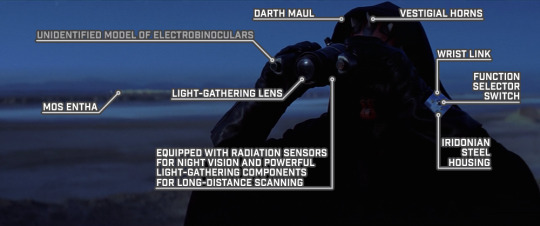
STAR WARS EPISODE I: The Phantom Menace 00:51:38
I believe that the lights in the distance of this shot are Mos Entha, as opposed to Mos Espa. Maul first turns around (next shot), then pans to left (west) which according to the map in Complete Locations (pg 28) would indicate that he first views Mos Entha in the east.
Map showing Mos Entha to the east, across Xelric Draw from Maul’s landing site. When he pans to the left he would be facing Mos Espa. It would also mean he landed facing the east, then turned north to view Mos Espa. (Map from Complete Locations)

#Star Wars#Episode I#The Phantom Menace#Tatooine#Xelric Draw#unidentified electrobinoculars#Darth Maul#vestigial horns#wrist link#function selector switch#Iridonian steel housing#light-gathering lens#radiation sensors#Mos Entha#night vision
4 notes
·
View notes
Text

#:))))))#that is NOT snow it's what happens when radiation particles/photons hit the camera sensor!!!!!!#google it it's pretty neat. only just a handful of examples tho#this is the funniest shit ever to me. peak humor#like the fucking way this is even tied to the plot and radiation poisoning is crazy#the way this fucking fits for the memory ending. ariane does not remember how radiation fit her....#this is an inside joke from another fandom actually. there was a sentence from this other game that said#“i knew x suited you best!” and i put radiation instead of x. and made the character this sentence was about glow green#signalis#signalis spoilers#ariane yeong#signalis ariane#signalis elster#lstr 512#signalis meme
43 notes
·
View notes
Text
The spread of radioactive isotopes from the Fukushima Daiichi Nuclear Power Plant in Japan in 2011 and the ongoing threat of a possible release of radiation from the Zaporizhzhia nuclear complex in the Ukrainian war zone have underscored the need for effective and reliable ways of detecting and monitoring radioactive isotopes. Less dramatically, everyday operations of nuclear reactors, mining and processing of uranium into fuel rods, and the disposal of spent nuclear fuel also require monitoring of radioisotope release. Now, researchers at MIT and the Lawrence Berkeley National Laboratory (LBNL) have come up with a computational basis for designing very simple, streamlined versions of sensor setups that can pinpoint the direction of a distributed source of radiation. They also demonstrated that by moving that sensor around to get multiple readings, they can pinpoint the physical location of the source. The inspiration for their clever innovation came from a surprising source: the popular computer game "Tetris."
Read more.
#Materials Science#Science#Radiation#Nuclear power#Isotopes#MIT#Computational materials science#Sensors
25 notes
·
View notes
Text
run fast
run cold
3 notes
·
View notes
Text

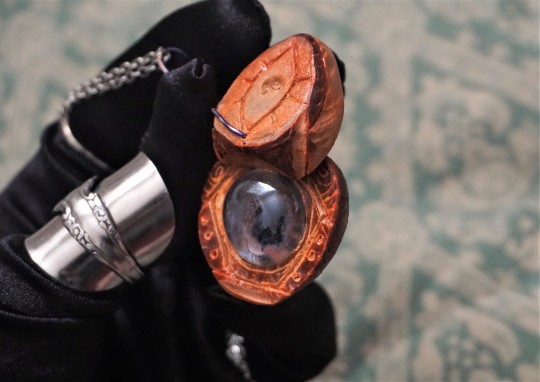


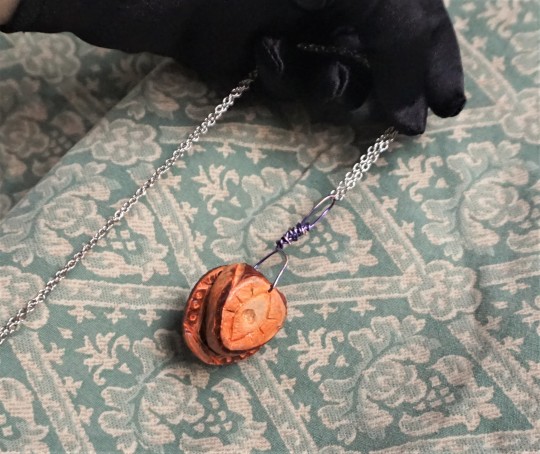
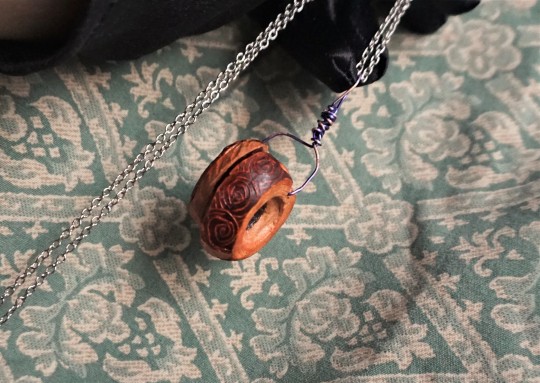
-- Poorly Constructed Enchanted Tool --
A small tool carved from a fruit tree seed. Energy to power the enchantment has seemingly run-out long ago, and the method of recharging is unknown - but, based on the appearance, it's very likely that this was once used for detecting magic. Usually, looking through the glass center would highlight areas of higher magical energy concentration present in the viewer's environment, even if they were otherwise obscured to the naked eye. While this form of enchantment itself is highly advanced, the craftsmanship of the item is far less neat or complex than what might be typically seen in similar devices. It may have been made as part of training/practice, or as a hasty replacement for a previous tool that had broken.
#written from the perspective of some fantasy traveler who checks all of the local thrift-stores and lost & found places for every#town they visit - looking for interesting items and documenting them or something#In reality - just another one of my goofy little avocado pit carvings lol. Still working on inlaying little stones in them and stuff#I don't really have the tools to make super intricate stuff but doing little plain swirly patterns is still fine enough lol.#WORKING ON NEW POLL ADVENTURE also I know I know it's been months.. I have been Busy and struck by the evils of summer#But like I mentioned in the previous one I do want to at LEAST finish the quest with the egg lol#ANYWAY.#Things like this would plausibly exist in Nanyevimi (my fantasy world) but wouldn't be very common as - like mentioned- this would be an#extremely advanced enchantment. REALLY advanced mages could sense magic around them (to varying degrees of pinpoint accuracy of location#) without even having to use any external device. But for a majority of people there's really no way to know someone is using magic near#you unless you either see visual proof or if it's strong enough to feel effects from it (since magic is kind of like radiation in that the#higher energy/more of it youre exposed to the more it damages you/can make you sick/etc.) and even then most people would just be like#'hmm why do I feel so nauseous and bad out of nowhere?' likely wouldn't directly think to link it to magic. Thus the only really reliable w#way isto just hone your senses over like 500 years as you become an expert mage - OR use enchantments like these. But a 'sense magic' encha#ntment is not as common as a just 'magic is not allowed here' enchantment. If you wanted to prevent magic from being usedin a space#it's easier to just put up a broad barrier enchantment around that space than to have some sort of Magic Sensor to pick out if it's being#done and then handle each individual case of it . etc. etc. These sort of things can have their uses (especially for people investigating#things or trying to be secretive about detecting something etc.) but are less common - especially in this form (where visuals are used. itd#be more likely to jsut have like 'piece of metal that gets warm or cool depending on magic nearby'.) ANWAY so this is why it's a notable#object. Though a majority of the realm is not very magic literate - if you were a researcher or a mage and found this at a pawn shop you'd#definitely be like 'oohhh!! :0 inch resting... ' if not you might just be like 'oh cool necklace!' lol#also love the quick 2min ''costume'' for the image of it being used. literally just 'wrap yourself in scarves from the waist up' and slap o#a wig and ears lol#on this blog I guess since it's worldbuilding related and technically art.. maybe more like crafting? I should have a crafts tag lol.. hmm
58 notes
·
View notes
Text
I understand that it's become a shorthand for "bad post" but am I the only one who thought that putting a water filter on a post was supposed to symbolize that it was specifically radioactive, and that it was submerged to shield us?


#then there's that visual snow effect ppl put thats def supposed to be the cameras sensors getting fucked by radiation#but that's a little more obscure and also not in the tumblr pic editor
5 notes
·
View notes
Text

I'll have to research that
#fine I'll bite#<<<this blog's ask tag#btw quite related but in lucy's voiceline she noted that she can feel the warmth of Vertin's hand radiating to her core#what did she mean by that#does she have heat sensors in there? why?#so does she have sensors in her ports???#lets find out???????????#cw suggestive#should i just tag as#fine ill bite
2 notes
·
View notes
Text


That's Radium!
#the graph is terrible i havent calibrated the sensor yet or done anything to remove the background radiation#radiation#radioactive#antique#my first radium :)#30$ and the watch still works#not that ill be wearing it
1 note
·
View note
Text
Solar Meters vs. Solar Radiation Sensors: What’s the Difference?
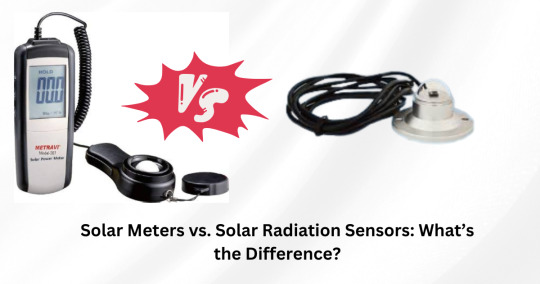
Confused between solar meters and solar radiation sensors? Discover their key differences, functions, and how to choose the right one for your solar energy needs!
0 notes
Text
I hate car stuff so much bc idk shit about it
#i told them just do the airbag and I'm getting the impression that's okay but i am stressed about it anyways#this guy was like oh plus if the sensor needs replacing that's another 600 so ur looking at 4k and we havent checked the radiator yet 🔪#the car cost 5.5k btw
0 notes
Text
Harnessing the Power of Sunlight: The Role of Solar Radiation Sensors
As the world continues to shift towards renewable energy sources, solar power has emerged as a frontrunner in the race to reduce our dependence on fossil fuels. Central to the efficiency and effectiveness of solar power systems is the accurate measurement of solar radiation, a task accomplished by solar radiation sensors. Among these, the pyranometer stands out as a vital instrument for anyone involved in solar energy projects.
Understanding Solar Radiation
Solar radiation is the energy emitted by the sun, which reaches the Earth's surface. It is a crucial parameter for various applications, including climate studies, agricultural planning, and, most importantly, solar energy generation. Solar radiation is typically measured in watts per square meter (W/m²) and includes direct sunlight, diffuse sky radiation, and reflected radiation from the ground.
What is a Solar Radiation Sensor?
A solar radiation sensor is a device designed to measure the amount of solar energy received in a given area over a specified period. These sensors are essential in solar energy systems for optimizing the placement and efficiency of solar panels, ensuring that they capture the maximum possible sunlight. By providing accurate data on solar irradiance, these sensors help in predicting the performance of solar power installations and in conducting energy audits.
The Role of Pyranometers
The pyranometer is one of the most common and reliable types of solar radiation sensors. It is specifically designed to measure the global solar radiation, which includes both direct sunlight and diffuse radiation from the sky. Pyranometers are used extensively in meteorological research, agricultural studies, and solar energy applications.
How Pyranometers Work
Pyranometers consist of a thermopile sensor beneath a glass dome or sometimes two domes. The thermopile sensor generates a voltage in response to the temperature difference created by solar radiation hitting its surface. This voltage is then converted into a measure of solar irradiance. The glass dome serves to protect the thermopile from environmental factors like wind and precipitation while allowing solar radiation to pass through.
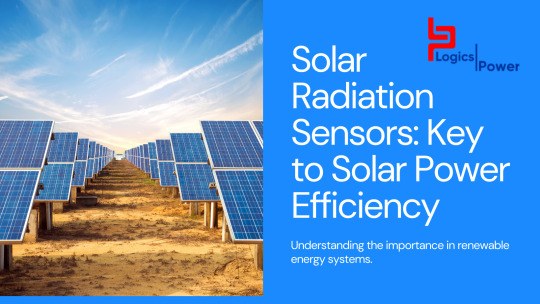
Types of Pyranometers
There are several types of pyranometers, categorized based on their precision and application:
1. First-Class Pyranometers: These are high-precision instruments used for scientific research and are often calibrated to international standards.
2. Second-Class Pyranometers: These are used for general meteorological applications where high precision is not critical.
3. Third-Class Pyranometers: Also known as low-cost pyranometers, these are used for applications where a rough estimate of solar radiation is sufficient, such as in some educational or small-scale solar projects.
Applications of Pyranometer Solar Radiation Sensors
Solar Energy Systems
In solar energy systems, pyranometers play a crucial role in monitoring and optimizing performance. By providing real-time data on solar irradiance, these sensors help in adjusting the angle and orientation of solar panels to maximize energy capture. They also assist in identifying potential issues, such as shading or panel degradation, by comparing actual performance against expected outputs.
Meteorological and Climate Research
Pyranometers are indispensable in meteorological stations for measuring solar radiation, which is a key variable in weather forecasting and climate modelling. Accurate data on solar irradiance helps scientists understand and predict climate change patterns, assess the impact of atmospheric conditions, and develop more accurate weather models.
Agricultural Applications
In agriculture, pyranometers are used to measure the amount of solar energy available for crops, which affects growth rates and yields. By understanding solar radiation levels, farmers can optimize planting schedules, irrigation practices, and crop selection to improve productivity.
Building and Construction
In the building and construction industry, pyranometers are used to assess the solar potential of a site, aiding in the design of energy-efficient buildings. They help architects and engineers determine the best placement of windows, solar panels, and other elements to harness natural light and reduce energy consumption.
Conclusion
As the demand for renewable energy continues to rise, the importance of accurate solar radiation measurement cannot be overstated. Solar radiation sensors, particularly pyranometers, are essential tools in the optimization and performance assessment of solar energy systems. By providing precise data on solar irradiance, these sensors enable better design, improved efficiency, and enhanced sustainability in various fields, from renewable energy and agriculture to meteorology and construction.
Harnessing the power of sunlight effectively requires a deep understanding of solar radiation, and with the help of advanced solar radiation sensors like pyranometers, we can continue to make strides towards a cleaner, more sustainable future.
Source:https://solarminitoringsystem.blogspot.com/2024/06/harnessing-power-of-sunlight-role-of.html
#solar radiation sensor#solar radiation sensor in india#pyranometer solar radiation sensor#pyranometer
0 notes
Text

Hardy transistor material could be game-changer for nuclear reactor safety monitoring
The safety and efficiency of a large, complex nuclear reactor can be enhanced by hardware as simple as a tiny sensor that monitors a cooling system. That's why researchers at the Department of Energy's Oak Ridge National Laboratory are working to make those basic sensors more accurate by pairing them with electronics that can withstand the intense radiation inside a reactor. The ORNL research team recently met with unexpectedly high success using a gallium nitride semiconductor for sensor electronics. A transistor made with the material maintained operations near the core of a nuclear reactor operated by research partner The Ohio State University. Gallium nitride, a wide-bandgap semiconductor, had previously been tested against the ionizing radiation encountered when rockets hurtle through space. Devices with wide-bandgap semiconductors can operate at much higher frequencies, temperatures and irradiation rates. But gallium nitride had not faced the even more intense radiation of neutron bombardment.
Read more.
#Materials Science#Science#Transistors#Nuclear power#Sensors#Electronics#Radiation#Gallium nitride#Semiconductors#Gallium#Nitrides
13 notes
·
View notes
Text
youtube
Melexis: Temperature Sensors MLX90632 Medical
https://www.futureelectronics.com/resources/featured-products/melexis-mlx90632-infrared-temperature-sensor . Melexis MLX90632 infrared sensor is based on established far infrared (FIR) technology that utilizes the fact that every object emits heat radiation proportional to its temperature. The ultra-small device includes the sensor element, signal processing, digital interface and optics allowing integration into a wide variety of space-constrained applications. https://youtu.be/th0h-oMG6Wc
#Melexis#MLX90632#MLX90632 Medical#Temperature Sensors#infrared sensor#infrared#FIR#QFN#radiation#Youtube
0 notes
Text
Hey guys! Sorry I haven’t really posted anything in a while. I’m still working on Prismatic Kingdom, but there’s also some other crossovers and original stuff that’s been occupying my time and imagination.
I’m currently working on a series of pictures themed to the song ‘I am the Voice’ by Celtic Woman.
I’ve been meaning to make another side blog dedicated to the subject matter of that series but I’m waiting until my Tumblr-versary this month to do so.
I also have a job, so that takes up the majority of my time most days
Just wanted to give a quick little life update
Happy Easter and have a good day!
#life update#sorry i haven’t been posting#my car has also been an issue lately#the radiator is leaking and the dealership made me pay 1700 just for inspection and fixing the sensors#I took it to a smaller mechanic for a second opinion#wish me luck
1 note
·
View note
Text
0 notes
Text
Vulture Droid Starfighter

STAR WARS EPISODE I: The Phantom Menace 01:58:35
#Star Wars#Episode I#The Phantom Menace#Naboo system#Battle of Naboo#Vuutun Palaa#Droid Control Ship#Lucrehulk-class LH-3210#DFS-327#composite shell#unidentified Vulture droid starfighter#flight assault blaster#energy torpedo firing channel#active sensor#long-wavelength radiation#droid signal receiver station#claw angle adjust ram/shock absorber#alclad alloy plating
0 notes